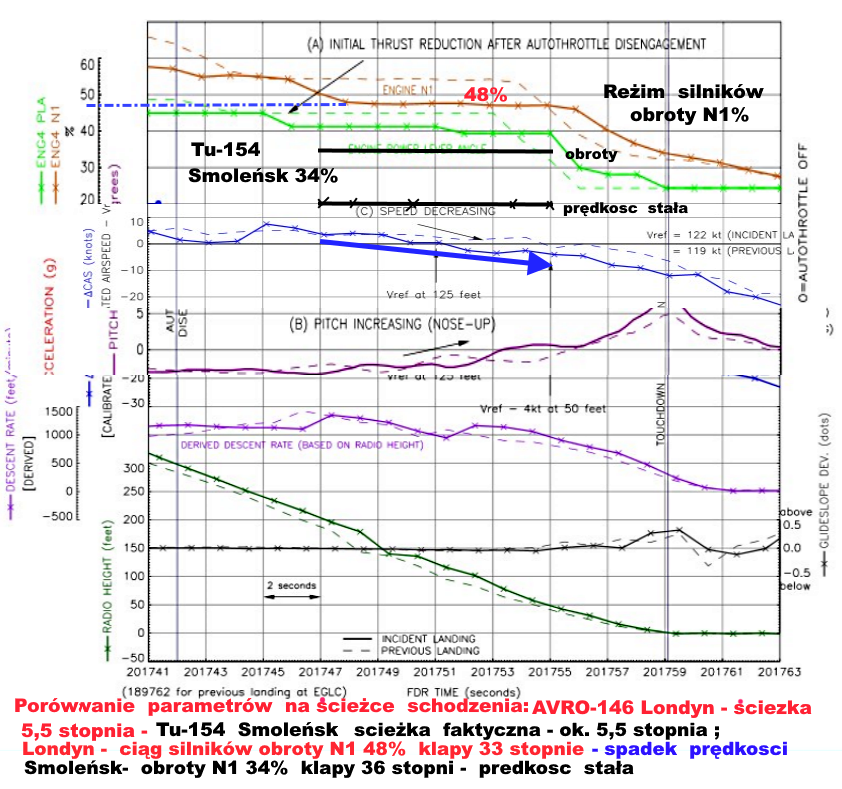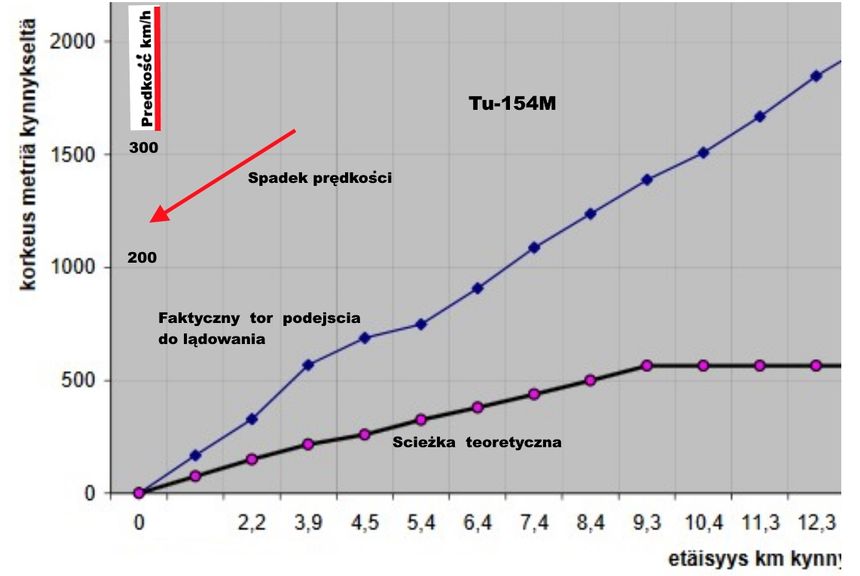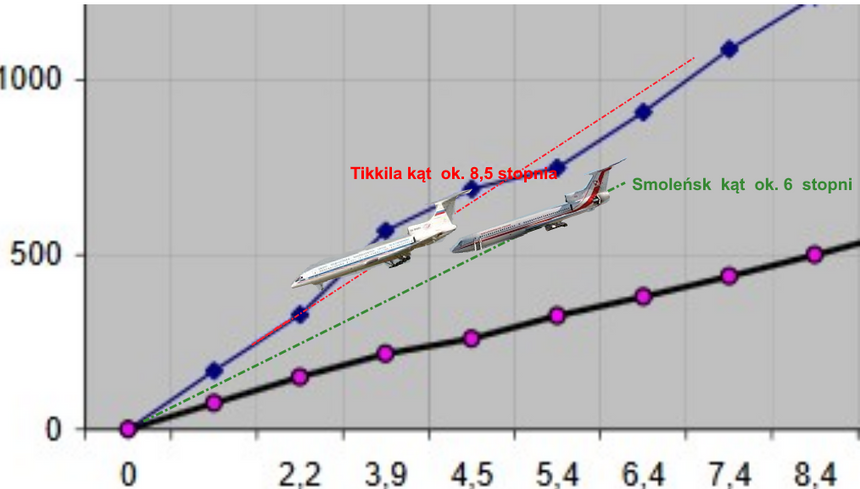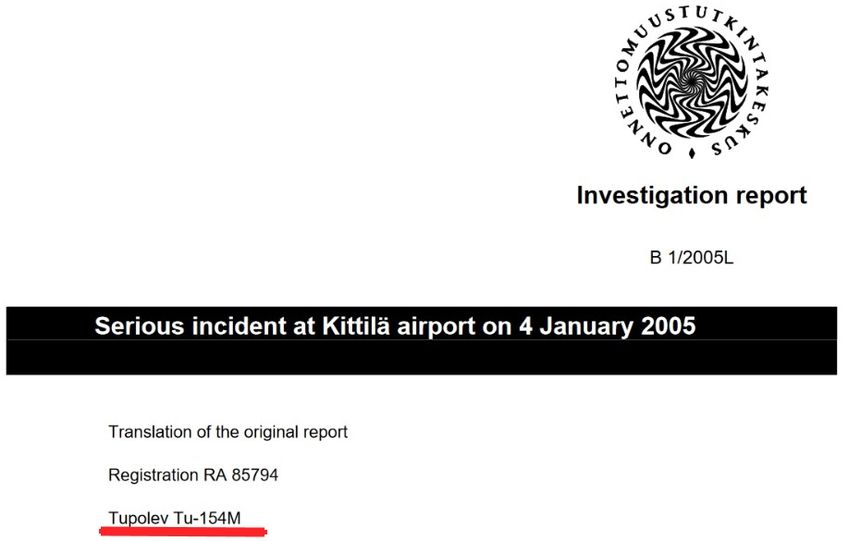Parametry zniżania Tu-154 zaprezentowane na wydrukach w raportach MAK/Laska są fizycznie niemożliwe.
Czy jest to błąd , czy jest inne wyjaśnienie, jakie ?
Nie wiadomo.
Sprawdziłem:
- Nigdy przy zniżaniu się po ścieżce samolotu w konfiguracji do lądowania a więc z wysuniętą mechanizacją skrzydeł , podwoziem, gdy silniki pracują na minimalnym ciągu lub nawet na niskim ciągu znacznie wyższym niż miał Tu-154 w Smoleńsku ( ale nadal w strefie niskiego ciągu) samoloty nie utrzymały prędkości początkowej ( jaką miały w momencie obniżenia ciągu)
Znalazłem już 6 kolejnych przykładów , gdy w warunkach o jakich mowa w notce prędkość samolotu spada.
Przeszukiwałem incydenty lotnicze np. wg takich słów kluczowych:
" idle glideslope incident"
nie znalazłem ani jednego przypadku innego niż ten zobrazowany poniżej.
Gdyż wynika to z praw fizyki..
Prędkość zaczyna spadać momentalnie- od chwili gdy obniża się reżim pracy silników; to efekt powstałej nierównowagi sił- wypadkowa siła hamująca ( siły oporu większe niż suma sił ( ciągu + składowa siły ciążenia) powoduje opóźnienie ruchu samolotu.

incydent lotniczy w Londynie:
https://assets.publishing.service.gov.uk/media/5422fef9ed915d13740009a3/Avro_146-RJ100__G-CFAH_11-06.pdf
The data presented for the incident landing starts just over 8 seconds before the touchdown with the aircraft on the glideslope at 320 ft RA, 27 kt CAS (e Vref +5); descending at about ,200 ft/mn, wth about 58% N on each engine2. Autothrottle was engaged throughout the descent untl 300 ft, 7 seconds before touchdown.
Immediately after the disengagement of the autothrottle, the N for each engne reduced by about 3%,
as engne control reverted back to manual control (or Thrust Modulaton mode).Three seconds after the disengagement of the autothrottle, the power levers for all four engines were retarded slightly, reducing N to 48% two seconds later (Pont A of Fgure ). As the aircraft descended, ts pitch began to increase (Pont B of Fgure ) and the airspeed began to decrease (Point C of Figure 1) while maintaining the 5.5º glideslope.
at 50 ft, when the power levers were retarded for the flare, the airspeed had decreased to Vref –4 kt and the descent rate was about 1060 ft/mn ( w tym momencie prędkość zniżania wynosiła ok.5,3 m/s- była zmienna ( na tym odcinku w zakresie ok 5,3 -7,5 m/s)
w ciągu ok 8 sekund prędkość spadła o ok 15 km/h
Tu 154 leciał ok 20 sekund po ścieżce o podobnym nachyleniu a moc silników była niższa ( mały gaz)i prędkość nie spadała
Zapraszam przekonanych o prawidłowości danych w raportach MAK/Laska do podania kontrprzykładu-
choć 1. ( słownie jednego ) przykładu gdy parametry są analogiczne jak te ze Smoleńska.
Są tu na salonie:
Fizycy
Lotnicy
Inżynierowie
Technicy
nawet jeden astrofizyko-lotnik z wysokim indeksem Hirscha
Znajdźcie, pokażcie choć jeden przykład przeciwny do tych , które ja podaję- jeśli uważacie, że jest inaczej niż opisałem to w notkach.
Jak nie to spadać na drzewo.
zobacz też:
https://www.salon24.pl/u/niegracz/961701,zanik-praw-aerodynamiki-i-fizyki-nad-smolenskiem-c-d-katastrofa-tu-154
***
No dobra powie ktoś - ale to jest zupełnie inny samolot niż Tu-154 !!!
Nie ma to znaczenia- prawa fizyki są jednakowe dla wszystkich typów samolotów.
Ale- gdyby przypadkiem ktoś jeszcze miał wątpliwości - podaję analogiczny przykład dla samolotu
Tu-154M
-spadek prędkości na ścieżce zniżania przy nachyleniu większym niż ścieżka standardowa


https://turvallisuustutkinta.fi/material/attachments/otkes/tutkintaselostukset/en/ilmailuonnettomuuksientutkinta/2005/b12005l_tutkintaselostus/b12005l_tutkintaselostus.pdf

https://turvallisuustutkinta.fi/material/attachments/otkes/tutkintaselostukset/en/ilmailuonnettomuuksientutkinta/2005/b12005l_tutkintaselostus/b12005l_tutkintaselost
Tu-154
07:28:05. N1 RPM was 55–58%
However, once the thrust levers were reset, engine RPM decreased to 40% whereafter it continued to gradually de-crease, finally reaching 30% at 07:31:40
07:28:20 the middle spoilers on the upper surface of the wing were deployed and the trailing edge flaps were set at 15°
Flaps were further extended to 28° at 07:29:00
07:29:30 thirty seconds later the undercarriage was lowered at approximately 8,000 ft (2440 m) and at the airspeed of 180 kt (333 k
At 07:31:15 the flaps were further extended to 45° at approximately 2,000 ft QNH (610 m), whereafter airspeed began to decrease from 180 kt (333 km/h).
Slowly decreasing30% at 07:31:40.
Airspeed had decreased to 130 kt (240 km/h) two sec-
B 1/2005L Serious incident at Kittilä airport on 4 January 2005 4 seconds before touchdown
At 07:27:56 AFIS replied: “Roger”. Based on FDR information, the aircraft left FL 100 (3,050 m) at 07:28:15. Radar plots place it 11.5 NM (21 km) from the threshold of run-way 34 at that time. The FDR showed that at 07:28 airspeed bled off from 280 knots (520 km/h) to 220 kt (407 km/h) during the descent. During the approach the thrust lever angles of engines number one and three were 20° and engine number two 18° until they were set at the zerp degree position at 07:28:05. N1 RPM was 55–58%. However, once the thrust levers were reset, engine RPM decreased to 40% whereafter it continued to gradually de-crease, finally reaching 30% at 07:31:40.
During final approach the sink rate varied between 1,500–2,000 ft/min (7.6–12.7 m/s), and was 2,500 ft/min (12.7 m/s) at 07:31:52, i.e. right before touchdown. The nominal sink rate on the 3.4° ILS GP at 130 kt (240 km/h) is 780 ft/min (4 m/s).
Section 4.5.2.4 in the Tu-154M aeroplane flight manual gives the following directive: “Should the GPWS sound an alert, sink rate must immediately be reduced. If the flight occurs above rolling or hilly terrain or if the flight crew is not familiar with the contours of the underlying terrain, altitude must immediately be increased, albeit by not exceeding permitted acceleration or angle of attack limits and the thrust lever shall be moved to takeoff position and be kept there until the alert ceases”.
Section 4.5.1.2 in the Tu-154M aeroplane flight manual states that in order to avert the risk of a flameout, it is not permissible to reduce engine RPM to under 61% during ap-proach and landing.
According to FDR information, at 07:31:45 all thrust levers were pushed from the zero degree position to the 60° position within five seconds. The N1 RPM of all engines was approximately 30% but it rapidly began to increase at 07:31:47.
***

Na ścieżce zniżania pasażerski samolot odrzutowy przy reżimie pracy silników "mały ciąg" ( idle thrust) w konfiguracji do lądowania a więc z wysuniętą mechanizacją skrzydła i wysuniętym podwoziem będzie tracił prędkość w tempie 20-30 mil/h na odcinku 1 mili. (36-54 km/h na odcinku 1,8 km)
UWAGA: zdanie: Prędkość ma w przybliżeniu stałą wartość na ostatnim odcinku podejscia ( to jest poniżej 1000 stop( 300m)mówi juz o podejsciu ustabilizowanym przy normalnym ciągu silników.
( przy 5,5 stopniach będzie to mniej ale prędkość będzie spadać)
Performance of the Jet Transport Airplane: Analysis Methods, Flight ...
Autorzy Trevor M. Young
Od maja 2010 wskazuję na sprzeczność narracji MAK z elementarnymi faktami,śladami oraz prawami fizyki. "Jeszcze nigdy tak niewielu nie stanęło przeciw tak Wielu by bronić prawdy dotyczącej tragicznego zdarzenia lotniczego." "Jeszcze nigdy tak nie skompromitowało się środowisko techników, ekspertów, naukowców milcząc gdy do narzucania kłamliwej narracji łamie się elementarne prawa fizyki i ignoruje wiedzę."
Nowości od blogera
Inne tematy w dziale Polityka

